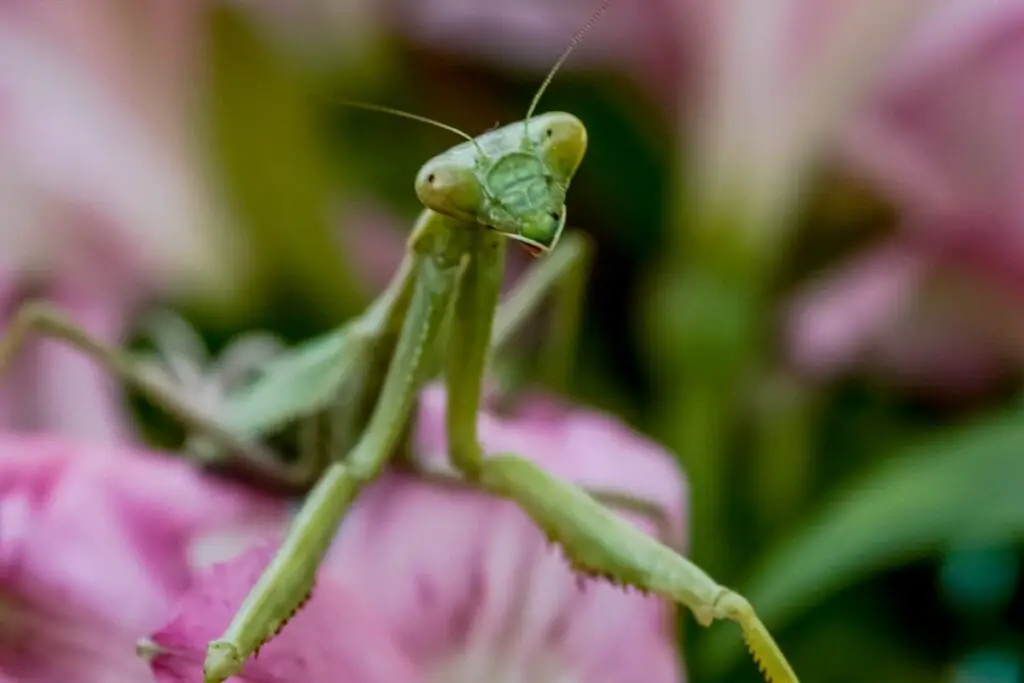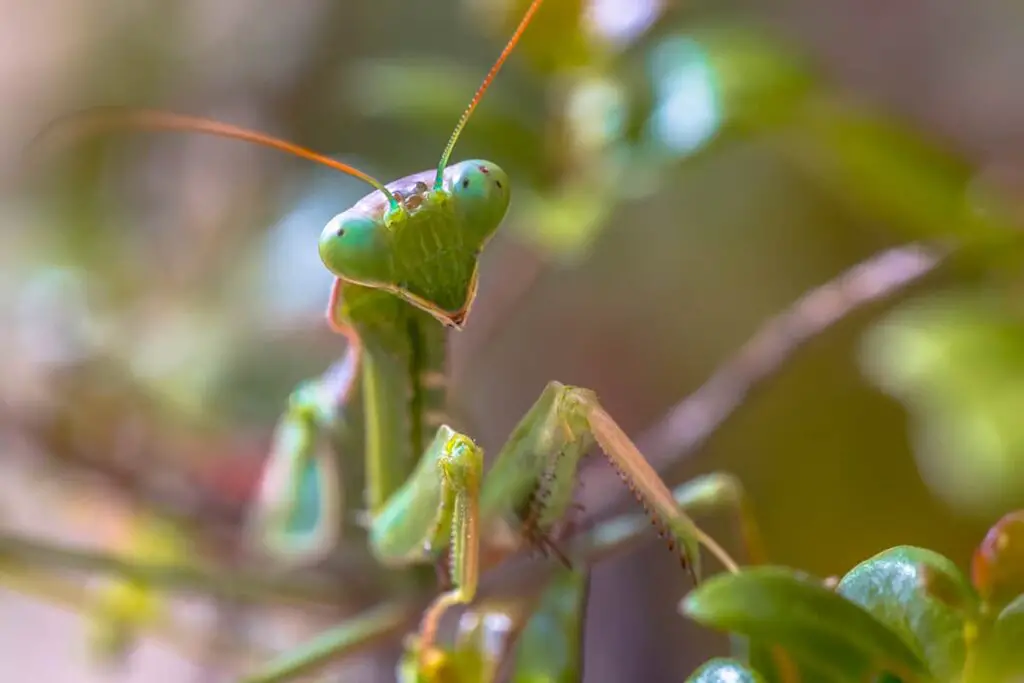Creating a mantis-friendly environment in your garden isn’t only about enjoying the presence of these fascinating insects; it’s also about championing biodiversity and natural pest control. Praying mantises are renowned for their pest-eating habits, which can help you manage garden nuisances in an eco-friendly manner. Setting up a habitat that caters to their needs means you’ll invite these natural predators to take up residence in your outdoor spaces.
To start with attracting praying mantises to your garden, it’s essential to understand what they need to thrive. These insects prefer environments where they can safely hunt and reproduce. By introducing certain plants and maintaining organic gardening practices, you create a sanctuary for them. Tall grasses, shrubs, and certain flowering plants not only provide the necessary shelter but also attract the prey mantises feed on.
Ensuring the comfort and safety of praying mantises in their habitat involves some careful planning. They require a space that both retains heat and humidity and is secure enough to prevent escape. When you design your garden with these factors in mind, it won’t just benefit mantises; it will become a more balanced and healthy ecosystem for a variety of beneficial insects and plants.
Understanding Mantis Habitats
To create a mantis-friendly environment, it’s important to understand the specific needs of various mantis species and the conditions that support their well-being.
Mantis Species Overview
Mantises are a group of over 2,400 species, each adapted to thrive in specific environments. You’ll find them in diverse habitats, from tropical rainforests to temperate grasslands. Some species, like the Chinese Mantis, are large and can change color to blend with their surroundings, while others, like the Carolina Mantis, are smaller and often found in gardens.
Ideal Habitat Conditions
For mantises to thrive, they require an environment that meets their behavioral and physiological needs. Temperature is essential, with most species preferring a range between 20-30°C. They need adequate space—about three times their length in height and width—to move and hunt effectively. Providing ample vegetation gives them places to hide, hunt, and lay their eggs.
- Lighting: Bright indirect light for natural day-night cycles
- Humidity: Sufficient for the species, often around 60-80%
Common Habitat Challenges
Creating a suitable habitat for mantises comes with its challenges. Pesticides and pollutants in your garden can be harmful, and non-native mantis species can disrupt local ecosystems. In colder climates, providing consistent warmth and light year-round is essential. Achieving and maintaining the right humidity levels can be difficult but is critical for mantises to molt and grow properly.
Garden Design for Mantis Support
Creating a mantis-friendly environment in your garden involves strategic planning with specific types of plants and thoughtful placement. This way, you can provide the necessary resources for these beneficial insects to thrive.
Plant Selection
For your garden to support mantises, you’ll need to choose plants that attract them. Tall grasses and shrubs offer ideal hiding and hunting grounds. Include plants like roses and raspberries to entice these natural predators. It’s also advised to ensure a diverse range of vegetation, which supports the ecosystem by attracting various prey for the mantises.
Garden Layout
Design your garden with areas that are rich in foliage and hideouts. Distribute your plants evenly with open and closed spaces to allow mantises to maneuver freely. Ensure that tall grasses are interspersed among your flowers and vegetables to offer shelter and vantage points for these insects.
Water Sources and Shelter
Incorporate natural water features or shallow dishes to provide hydration for your mantis guests, being careful to avoid deep water that could be a hazard. To further create shelter and safe spots, leave some areas of your garden less manicured, which mimic the natural environments mantises are drawn to.
Maintaining the Mantis Environment
Creating a stable environment for mantises requires attention to several factors, ensuring they have everything they need to thrive.
Pest Management
Your mantis habitat should be kept free of pests that can harm the mantises. You can introduce ladybugs or lacewings, which are beneficial insects that do not compete with mantises, to help control pests such as aphids.
Seasonal Considerations
During winter, your outdoor mantis habitat may need additional insulation or a move to a sheltered area to protect mantises from cold weather. Conversely, ensure they have shade and water during hot summers to prevent overheating.
Mantis Population Monitoring
Regular inspection of your habitat helps monitor mantis health and population levels. Watch for signs of stress or overcrowding and take action by expanding your habitat or relocating some mantises if necessary.
Frequently Asked Questions
Creating a garden that supports and attracts praying mantises can establish a natural pest control system. Here, you’ll find answers to common questions that can help you build a friendly space for these fascinating insects.
What plants can attract praying mantises to my garden?
Incorporate plants like marigolds, daisies, and cosmos, as these can invite praying mantises by attracting smaller insects for them to feed on. Tall grasses and shrubs also offer a suitable environment for mantises to hunt and lay their eggs.
How can I create a suitable habitat for a praying mantis?
Design your garden with varied vegetation, including tall grasses and a mix of flowering plants, to offer both hunting grounds and hideouts. Dead branches and leaves can provide places for mantises to nest and overwinter.
What should I include in a praying mantis enclosure to keep them happy?
Ensure that your mantis habitat at home mimics the outdoors with sticks for climbing, leaves for hiding, and an ample supply of live prey. Consistent temperature and humidity control are also essential for their well-being.
What is the ideal environment for a praying mantis to thrive?
Praying mantises favor a space with a mixture of plants for concealing themselves and hunting prey. An environment free from broad-spectrum pesticides is crucial, as these can harm mantises along with the pests.
How can I catch a praying mantis in my backyard safely?
When attempting to catch a mantis, gently coax it onto a stick or your hand, being careful not to grab or squeeze it. Avoid using any methods that might harm or stress the insect.
Are praying mantises beneficial to have in the garden, and why?
Praying mantises play a valuable role as a natural pest control agent by eating a wide variety of garden pests, like aphids and flies, which helps maintain the ecological balance in your garden.
Driven by a passion for those tiny creatures that rule our world, we at Bug Domain strive to be your go-to resource for information on insects.




